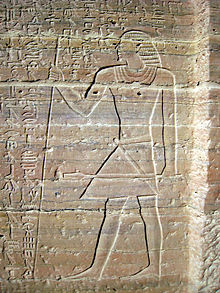Autobiography of Harkhuf
| Harkhuf | |
|---|---|
| Nomarch of the 1st nomos of Upper Egypt | |
 Harkhuf in a relief from his tomb at Qubbet el-Hawa. | |
| Successor | possibly Heqaib |
| Dynasty | 6th Dynasty |
| Pharaoh | Merenre I, Pepi II |
| Burial | Qubbet el-Hawa, Tomb 34 |
The Autobiography of Harkhuf is a private tomb inscription from
His name sometimes spelled as Herkhuf, Horkhuf, or Hirkhuf, all that is known of his life comes from the inscriptions in his tomb at
He travelled a considerable distance to a land called Iyam, which probably corresponds to the fertile plain that opens out south of modern Khartoum, where the Blue Nile joins the White. However, Jean Yoyotte thought Iyam was located further north in the Libyan Desert.[5]
The inscriptions in Harkhuf's tomb reflect changes in the Egyptian world view that were occurring during the Late
Tomb inscription

The narration of Harkhuf's career is aforementioned by prayers for offerings and a good burial, and the list of virtues - standardized components of tomb-autobiography. Carved on the outside of the soft, flaking stone of the tomb are fifty-eight lines.[8] Listed below are the descriptions of the inscriptions on each side of the tomb.
Above the entrance (Eight lines)
Harkhuf has prayers for offerings and a good burial. He mentions an "offering which the king gives and Anubia."[9] This shows his significance and hierarchy in Egypt. Even the king gives an offering, revealing even further. Harkhuf states his titles such as Governor of Upper Egypt, prays for a peaceful journey in the afterlife, and mentions many feasts and that he be celebrated.[10] Lastly, a list of his virtues is included, such as never judging between two, helping other civilians, and building a house. This is very similar to the duties of a king; Harkuf, who is a highly esteemed priest has these king-like qualities to him.
Right side of entrance (Fourteen lines)
Harkhuf accounts his expedition to Yam (located in Upper Nubia),[11] the first time with his father, bearing gifts and products. The second trip was done alone where he traveled back through other foreign lands, noting that this has not been done by anyone else before, and again, bearing beautiful gifts. The third trip to Yam, he found that the ruler had gone to Tjemeh-land to smite the Tjemeh; however, Harkhuf was able to please the ruler of Yam, and Yam's ruler praised all the gods.[12]
Left side of entrance (Ten lines)
After satisfying the ruler of Yam, Harkhuf came down through the south of Irtjet and north of Setju. He found their ruler, who was impressed by all of his goods and products as well as the numerous troops from Yam with him, and led him with an escort to Irtjet's mountain path.[13]
On the far right (Twenty-six lines)
Harkhuf's tomb describes the text of a letter he received from the king Neferkare, where he vividly expresses his eagerness to see the pygmy whom Harkhuf was bringing back with him. For his success, Harkhuf is promised with many worthy honors by the king.[14]
Harkhuf's expeditions stated the only purpose was to reach Yam, acquire the desired products, and return to Egypt.[15]
References
Notes
- ^ OCLC 889165092.
- ^ a b "List of Rulers of Ancient Egypt and Nubia | Lists of Rulers | Heilbrunn Timeline of Art History". The Met's Heilbrunn Timeline of Art History. The Metropolitan Museum of Art. Retrieved 2017-05-24.
- ^ ISBN 0-8014-4050-5.
- ISBN 0-8014-4050-5.
- ^ Yoyotte, Jean (1953). Pour une localisation du pays de Iam. BIFAO 52 (in French). Cairo: Bulletin de l’Institut français d’archéologie orientale. pp. 173–178.
- ISBN 0-415-94753-7.
- ^ Breasted, James Henry (1906). Ancient Records of Egypt. Vol. Part One. Chicago: University of Chicago Press.
- ^ Lichtheim
- ^ Lichtheim, p.23
- ^ Lichtheim, p.24
- JSTOR 40001089.
- ^ Lichtheim, p. 25
- ^ Lichtheim, p.25-26
- ^ Lichtheim, p.26-27
- ^ O'Connor, p. 29
Sources
- Miriam Lichtheim, Ancient Egyptian Literature: A Book of Readings, Vol.1, Berkeley 1973, pp. 23–27
- George William Murray, Harkhuf's Third Journey, The Geographical Journal, Vol. 131, No. 1 (Mar., 1965), pp. 72–75
- James Henry Breasted, Ancient Records of Egypt, Vol. I, Chicago 1906
